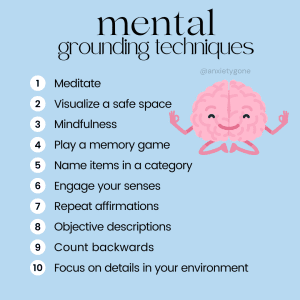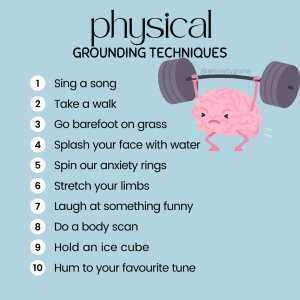Full Disclosure: Clicking on these links could mean a tiny commission for me, at no extra cost to you.
When anxiety strikes, it can feel like your mind is drifting away on a cloud while your body is stuck in place. This strange feeling is formally known as dissociation or dissociation, and it’s a fairly common symptom experience by many people with anxiety disorders. But here’s the good news: there are all kinds of coping methods, such as fidget rings and grounding techniques for anxiety, that can bring you back to the present moment fast. Whether you need a quick fix in the middle of a stressful day or a go-to method to break you free of an anxiety attack, we’ve got you covered with 32 powerful grounding techniques will help you feel calmer, more in control, and ready to take on whatever comes your way. Let’s dive in!
Advertisement
💚 Ready to Start Healing?
Therapy can change lives — and BetterHelp makes it easy. Get matched with one of 20,000+ licensed therapists and begin your journey from the comfort of home. Services start at just $65/week — no waiting rooms, no commute.
What is Grounding?
Grounding is a powerful technique used to bring your mind and body back to the present moment when anxiety, stress, or overwhelming thoughts take over. It helps you break free from racing thoughts, emotional distress, or dissociation by reconnecting with your surroundings through sensory awareness, movement, or mental exercises.
Think of grounding as an anchor; just like a worry stone, fidget ring, or healing stone for anxiety. These fidget tools keep your hands engaged and mind focused with physical touch. Grounding techniques do the same, helping pull you back to reality when anxiety tries to take your mind for a ride. Instead of getting lost in worry, grounding techniques redirect your attention to what’s real, solid, and safe in the present moment.
How Grounding Techniques for Anxiety Work
When we start to think about something stressful, our amygdala, a section of the brain located in the temporal lobe, goes into action. The amygdala is responsible for our emotional responses, especially fear. 1 While it’s not only helpful, but essential for preparing us for emergency situations. For people with anxiety, this natural response sometimes detects threats when there really aren’t any.
Think of it like this: you have a negative thought about a potential danger or situation. Although your thought doesn’t necessarily mean it’s real, the amygdala perceives this as an “emergency” and initiates changes in our body, such as increased muscle tension, rapid heartbeat, and faster breathing, all in an effort to protect you. It then interprets these bodily changes as further evidence that something is wrong, further activating the amygdala and creating a vicious cycle of escalating anxiety.
Thankfully, grounding techniques can break this cycle. By refocusing on your body and what you’re physically feeling, you get out of your head and divert your mind away from anxious or stressful thoughts, bringing yourself back into the present moment. As such, grounding techniques for anxiety help by:
- Creating a mental distraction: The more attention you give your anxious thoughts and feelings, the bigger and more overwhelming they become. Grounding techniques work by redirecting your mind to focus on benign, non-threatening thoughts vs. thoughts that are adding to your anxiety.
- “Resetting” your nervous system: When you’re anxious, your sympathetic nervous system goes into overdrive and your body gets ready to either fight the perceived threat or flee from it (i.e., you go into fight or flight mode). Grounding techniques, like deep breathing, help your body snap out of fight or flight mode and activate our parasympathetic nervous system which is responsible for helping us feel calm and relaxed.
Additionally, using grounding techniques can improve your mood 2, release nervous energy, rase physical symptoms of anxiety like rapid heartbeat or shallow breathing, regulate intense emotions and activate the body’s relaxation response
The Importance of Using Grounding Techniques for Anxiety
When anxiety hits and you start to dissociate, it can feel like you’re spiraling out of control. Your mind races, your body tenses, and everything feels overwhelming. This is where grounding techniques for anxiety become essential in your healing journey. These techniques help pull you out of anxious thoughts and bring you back to the present, allowing you to regain control, calm your nervous system, and feel more centered.
One of the biggest benefits of grounding is its immediate effectiveness. Unlike long-term anxiety management strategies, grounding works in the moment, making it a go-to tool when stress levels rise. Something as simple as holding a worry stone, spinning a fidget ring, or using crystals for anxiety can instantly redirect your focus and soothe your nervous system.
Beyond instant relief, grounding techniques also help with:
- Reducing panic attacks by shifting focus from distressing thoughts to physical sensations.
- Enhancing emotional regulation by breaking cycles of overthinking and worry.
- Encouraging mindfulness and presence in daily life.
- Providing sensory stimulation, whether through spinner rings, sensory toys or stress balls, designed to calm the body and mind.
By incorporating grounding into your routine, you create a safety net of tools that can help you manage anxiety anytime, anywhere. Whether it’s through deep breathing, touch-based techniques, or mindfulness exercises, grounding is a simple yet powerful way to stay present and reclaim your inner calm.
When to Use Grounding Techniques
Grounding exercises are especially helpful for people experiencing:
- Anxiety disorders
- Urges for self-harm
- Substance use disorders
- Eating disorders
- PTSD or C-PTSD symptoms
- Dissociation
- Effects of childhood trauma
- Panic attacks or persistent feelings of being overwhelmed
- Chronic pain
Fast, Affordable Therapy and Medication
Medication and therapy work better together — and Hims/Hers make getting support simple. Connect with licensed providers online, receive personalized treatment plans, and access medication — all from the comfort of home. No long waits, no stress — just expert care made easy.
Best Grounding Techniques for Anxiety Relief
Anxiety can certainly cause a whirlwind of racing thoughts and overwhelming sensations and emotions, but there are all kinds of grounding techniques for anxiety that can help you get through it as quickly and comfortably as possible. These simple yet powerful coping strategies engage your senses, body, and mind to redirect your focus away from anxious thoughts and back to reality.
Whether you’re spinning a fidget ring, holding a worry stone, or practicing mindfulness, these grounding techniques are here to help you regain control, ease stress, and feel more centered – and calm.
Here are 32 effective grounding techniques to try and and have fun with, as you find the ones that work best for you!
Sensory Grounding Techniques (Engage Your Senses!)
1. Spin Your Fidget Ring
Anxiety creeping in? Time to put your fidget ring to work! The smooth, rhythmic motion of spinning or twisting the ring gives your restless hands something to do and your anxious mind something to focus on. This helps soothe your thoughts and bring you back to your body, ending the uncomfortable feelings.
Shop our collection of silver and gold spinning fidget rings on our online Mental Wellness store here.
2. Hold a Worry Stone
Running your fingers over the smooth surface of a worry stone or crystals for anxiety provides a calming tactile sensation that helps ground you.
3. Splash Cold Water on Your Face
The sudden chill on your skin interrupts anxious thoughts, bringing you back into the present moment. This physical shock interrupt the cycle of anxiety, providing a powerful distraction that instantly brings you down. Plus, the coldness is super soothing.
You can also use ice and place it on your pulse points or hot spots, or even toss an ice cube in your mouth.
4. Use Aromatherapy
Inhale calming scents like lavender, peppermint, or eucalyptus to soothe your senses and promote relaxation. Your sense of smell is directly linked to the brain’s emotional centers, and inhaling a soothing scent can quickly shift your focus away from anxious thoughts and calm your mind. Whether it’s the calming aroma of lavender, the refreshing scent of citrus, or the comforting fragrance of vanilla, engaging your sense of smell can promote relaxation and reduce stress.
5. Eat Something Mindfully
Take small bites, savor each flavor, and focus on the texture of the food you’re eating to start shifting your attention away from anxious thoughts and into the present moment. This mindfulness practice works even better if you’re chowing down on foods that help anxiety.
6. Squeeze a Stress Ball
The simple act of squeezing and releasing a stress ball gives your hands something to do, releasing built-up tension.
7. Touch Different Textures
Run your fingers over soft fabrics, smooth stones, or textured surfaces to bring yourself back to the present.
8. Listen to Music or Nature Sounds
Put on calming music or nature sounds and focus on the rhythm, instruments, or lyrics.
Mental Grounding Techniques (Redirect Your Thoughts!)
9. Count Backwards from 100
If that’s too easy, try counting by twos or fives to make it more challenging.
10. Read Something Aloud
Pick up a book, magazine, or even a product label. Reading out loud engages both visual and auditory senses, keeping your mind occupied.
11. Find Words Around You
Look for signs, billboards, or labels and count how many times a certain word appears.
12. Describe Your Surroundings in Detail
Pretend you’re narrating for someone who can’t see—list the colors, shapes, and textures around you.
13. Name All the Things in a Category
Try listing as many dog breeds, countries, or foods as you can think of.
14. Spell Words Backward
Challenge your brain by spelling simple words in reverse, forcing your mind to focus.
15. Recite a Mantra or Affirmation
Say something like “I am safe. I am strong. I am present.” to reassure yourself. Affirmations are positive statements shift your focus away from negative thoughts and towards more positive, empowering beliefs. This practice not only interrupts the cycle of negative thinking but also promotes a more optimistic mindset. Get a list of our favourite affirmations for anxiety here.
16. Visualize a Stop Sign
Imagine a big red stop sign in front of your anxious thoughts, signaling your mind to pause. Or your safe space or happy place. Do this while spinning your fidget ring for an extra boost of calmness.
Movement-Based Grounding Techniques (Get Active!)
17. Take a Quick Walk
Focus on the way your feet feel hitting the ground, the breeze on your skin, or the sounds around you.
18. Stretch Your Body
Roll your shoulders, stretch your arms, or do a quick body stretch to release tension. Stretching can be a powerful grounding technique for alleviating anxiety. By focusing on the gentle, deliberate movements of your body, stretching helps shift your attention away from anxious thoughts and onto the physical sensations you’re experiencing.
This mindfulness with your body can promote relaxation and reduce tension 3. Additionally, stretching can improve blood circulation and release muscle tightness, which often accompanies anxiety. Whether it’s a full-body stretch or targeting specific muscle groups, taking a few moments to stretch can help you reconnect with your body, fostering a sense of calm and grounding you in the present moment.
19. Do a Body Scan
Close your eyes and slowly check in with each part of your body, noticing any tension or sensations. This simple relaxation technique involves slowly directing your attention to different parts of your body, starting from your toes and gradually moving up to your head. By focusing on the sensations in each area, such as the tension, warmth, or tingling, you are able to bring your awareness into the present moment and ultimately, away from your anxious thoughts. This mindful practice also helps you reconnect with your physical self, providing a sense of calm and balance.
20. Exercise for 10 Minutes
Even a short burst of movement, like jumping jacks or dancing, can boost your mood.
21. Shake It Off
Shake your arms, legs, and entire body to release nervous energy and reset your system.
22. Tap Your Fingers in a Pattern
Try tapping each fingertip to your thumb in sequence to give your brain something to focus on.
23. Hold a Weighted Blanket or Weighted Pillow
The deep pressure from a weighted blanket provides a deep sense of security and calmness. Prefer a smaller option? Weighted pillows are now all the rage, offering the perks of a weighted blanket for on-the-go.
24. Press Your Feet Firmly Into the Floor or Grass
Ground yourself by noticing the solid surface beneath you and the way your body feels connected to it. You can also use this technique outside to connect with the earth under your feet for an even greater calming, grounding sensation.
Visualization & Mindfulness Grounding Techniques (Calm Your Mind!)
25. Visualize Your Safe Place
Picture a calming location, like a beach, forest, or cozy home. Imagine every sensory detail.
26. Picture Your Anxiety Floating Away
Envision your stress drifting off like a balloon or dissolving like mist.
27. Breathe in a 4-4-4-4 Pattern
Inhale for 4 seconds, hold for 4, exhale for 4, and hold again for 4.
28. Use the 5-4-3-2-1 Method
The 5-4-3-2-1 grounding technique is a simple yet powerful method to regain control during anxiety episodes. It’s all about distracting yourself by activating your five senses uses the things around you. The more specific you are, the more effective this method will be.
Here’s how you practice:
- 5 things you can see
- 4 things you can touch
- 3 things you can hear
- 2 things you can smell
- 1 thing you can taste
29. Hum or Sing Your Favorite Song
The vibrations from humming stimulate your vagus nerve, helping to ease anxiety. The rhythmic nature of singing and humming helps regulate your breathing, promoting a sense of calm. Plus, the emotional connection to a favourite song can instantly uplift your mood, providing comfort and a sense of familiarity.
Whether you’re belting out lyrics in the car or quietly humming to yourself, this musical distraction will help anchor you in the present moment and alleviate feelings of anxiety.
30. Play a Memory Game
Try recalling all the items in a specific room, listing song lyrics, or remembering past vacations. This relaxation activity engages your cognitive functions and shifts your focus away from anxious thoughts to a more structured mental task.
By recalling details such as a list of objects, names of people, or events from your past, you distract your mind with a challenging and engaging process. Memory games also stimulate your brain and promote mindfulness, helping you stay anchored in the present moment.
Whether it’s a classic game of matching cards or simply trying to remember all the items you saw in a room, playing a memory game provides a constructive and enjoyable way to alleviate anxiety and enhance mental clarity.
31. Use Positive Self-Talk
Remind yourself, “This is temporary. I am safe. I will get through this.” Using positive self-talk helps you counteract negative self-criticism and promote emotional healing. Plus, we tend to be our own worst critics, so we deserve some kindness for ourselves too.
32.Practice Gratitude
List three things you’re grateful for to shift your focus away from worry and towards gratitude. This quick anxiety technique is well-known for requiring your brain patterns to help you think and live a more positive life in general too.
33.Try EFT Tapping
Emotional Freedom Technique (EFT) involves tapping specific points on your body while repeating affirmations to ease anxiety. It’s a popular anxiety technique and you can even try it out for free with our exclusive 14-day trial here.
34. Try Breathwork Classes
Guided breathwork sessions help regulate your nervous system and bring immediate relief. More specifically, breathwork helps deactivate your sympathetic nervous system and activate your parasympathetic nervous system, promoting relaxation and reducing stress. Give it a try and experience the calming effects for yourself! Get your first month of online breathwork classes free here.
35. Laugh at Something Funny
Laughing at something can be an incredibly effective grounding technique for managing anxiety. Humour has a powerful way of shifting your focus from anxious thoughts to something light-hearted and enjoyable. When you laugh, your body releases endorphins, which can help reduce stress and promote a sense of well-being. Whether it’s watching a funny video, reading a joke, or reminiscing about a hilarious memory, taking a moment to laugh can break the cycle of anxiety. This simple yet impactful activity can help you stay grounded in the present moment, providing relief and a much-needed mood boost.
36. Do Something Artistic
Drawing, painting, or coloring engages your creative side and provides a calming, meditative effect. The repetitive motion of colouring and the satisfaction of seeing your artwork come to life can induce a state of mindfulness, promoting relaxation and reducing stress. Whether you’re filling in an adult coloring book or creating your own mandala designs, colouring provides a soothing and enjoyable way to stay grounded in the present moment, helping to calm your mind.
37. Touch Nature
Run your hands over a tree trunk, pick up a smooth stone, or hold a handful of soil, physically connecting with nature can be deeply grounding. The sensory experience of feeling the soil, smelling the flowers, and observing the growth of flower plants can shift your attention away from anxious thoughts, promoting a sense of calm and tranquility.
Gardening also offers a sense of accomplishment and connection to the natural world, which can enhance your overall mental health and well-being. Whether you’re planting new vegetable seeds or simply caring for your existing garden, this mindful activity can be a soothing and grounding practice for managing anxiety.
Shop Our Wellness Collection
Looking to bring more calm and mindfulness into your daily life? The Anxiety Gone Shop is your go-to destination for handpicked mental wellness and self-care tools that soothe, support, and empower.
From anxiety-easing fidget rings to soulful self-care products, you’ll find everything you need to relax and restore. Take the first step toward a calmer, more centered you today.
Final Thoughts on Grounding for Anxiety
Grounding exercises are excellent for calming yourself during intense moments. By incorporating various grounding methods into your daily routine, you can find immediate relief and develop long-term coping strategies. The key is a consistent practice is crucial; the more you integrate grounding exercises into your daily routine, the more effective and natural they become. Whether through physical, mental, or sensory techniques, a simple grounding can go a long way for reducing anxiety, distracting your mind away from anxious thoughts, resetting your nervous system and alleviating trauma symptoms.
Frequently Asked Questions
- How do grounding techniques help with anxiety?
Grounding techniques help shift focus away from anxious thoughts and reconnect with the present moment, reducing anxiety symptoms. - What is the 5-4-3-2-1 grounding technique?
The 5-4-3-2-1 grounding technique involves identifying five things you can see, four things you can touch, three things you can hear, two things you can smell, and one thing you can taste to divert attention from anxiety. - Can children use grounding techniques?
Yes, children can use grounding techniques, and they can be adapted to be more playful and engaging for younger age groups. - How often should I practice grounding techniques?
Practicing grounding techniques daily can help maintain mental health and manage anxiety effectively. - Are there any tools to help with grounding techniques?
Yes, tools such as mental health apps, books, and support groups can provide guidance and support for practicing grounding techniques. - Can grounding techniques be used during a panic attack?
Yes, grounding techniques can be very effective during a panic attack, providing immediate relief and helping to regain control.
Additional Resources
At Anxiety Gone, we believe in healing together. We’ve partnered with trusted wellness organizations to bring you the most effective tools, insights, and support. Some links may earn us a commission — always at no extra cost to you.
Join The Club
Connect with our private self-care community for daily support, exclusive tips, and inspiration. Join us today
Talk Therapy
Get matched with licensed therapists online through BetterHelp and begin your healing today. Start now
Hims/Hers
Receive personalized, affordable mental health care + medication from home — no insurance required. Learn more
Mental Health, Right to your Inbox
Subscribe to our newsletter for a place to rest your mental health and find ways to support your journey. Sign up
Emotional Freedom Technique
Tap your way to calm with scientifically backed stress relief. Our readers receive a 14-day free trial! Try EFT now
Mindfulness App
Access 2,000+ guided practices to support your mental health wherever you are + exclusive discount when you upgrade Try it
Online Breathwork
Experience calm and reset your nervous system with guided sessions and receive your first month free . Get started
Find a Helpline
If you need immediate support, visit our directory to find help near you. See helplines
Grounding Infographics
References:- The National Institute of Mental Health: Anxiety Disorders
- The effect of grounding the human body on mood (2015, April). National Library of Medicine.
- What Is Mindfulness? (2022). Greater Good Science Center at the University of California, Berkeley.











